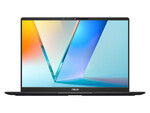Asus Vivobook S14 Q423
Specifications

Price comparison
Average of 1 scores (from 1 reviews)
Reviews for the Asus Vivobook S14 Q423
Source: Laptop Mag

The Asus Vivobook S14 gets a few things right with surprisingly strong gaming performance and nearly 18 hours of battery life, however its subpar overall performance gives it a major disadvantage against competitors. Considering its $949 price tag, an Intel Core Ultra 7 processor would have provided better value for your money, which shows in the Vivobook’s low overall performance score compared to similarly priced alternatives, such as the M3 MacBook Air (13-inch) or even the Lenovo Yoga Slim 7X. However, if you mainly want to use your laptop for low-power everyday tasks like web browsing, streaming, or studying, with some casual gaming on the side, the Vivobook S14 is up to the task.
Single Review, online available, Medium, Date: 12/05/2024
Rating: Total score: 70%
Comment
Intel Arc 130V: An integrated graphics adapter that lower-end Intel Lunar Lake family processors employ. This is a direct successor to the Arc 7 iGPU; DirectX 12 Ultimate is fully supported here and the iGPU also supports hardware-decoding a long list of popular video codecs such as h.266 VVC, h.265 HEVC, h.264 AVC, AV1 and VP9. It is clear the 130V isn't fast enough to run most triple-A 2024 games at 1080p. However, it's still more than good enough for an occasional gaming session Helldivers 2 and Ready or Not run perfectly well at 1080p / Low.
Modern games should be playable with these graphics cards at low settings and resolutions. Casual gamers may be happy with these cards.
» Further information can be found in our Comparison of Mobile Graphics Cards and the corresponding Benchmark List.
Core Ultra 5 226V: One of the 2 slowest Lunar Lake processors as of Nov 2024. It features 4 new Skymont E-cores and 4 new Lion Cove P-cores running at up to 3.5 GHz and 4.5 GHz respectively, along with the new Arc 130V iGPU and 16 GB of on-package LPDDR5x-8533 RAM. The 226V's level 3 cache is pretty small as compared to more expensive Ultra 7 2xxV and Ultra 9 2xxV chips at 8 MB vs 12 MB. Its multi-thread performance is very close to the R7 7730U and the R7 7735U, and it eats up to 37 W in short-term loads.» Further information can be found in our Comparison of Mobile Processsors.











